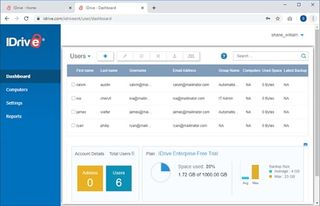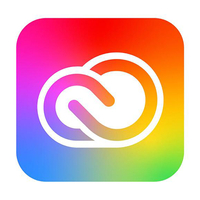Tom's Guide Verdict
Adobe Creative Cloud is a powerful creativity suite for individuals and businesses, but falls behind as a cloud storage platform thanks to rigid pricing, slow speeds, and reduced support for external file types.
Pros
- +
Second-to-none creativity suite for designers and artists
- +
Great real-time syncing features
Cons
- -
Rigid and expensive subscription plans
- -
Slow download and upload speeds
Why you can trust Tom's Guide
Adobe Creative Cloud is hardly the first name that springs to mind when you think of a cloud storage service. After all, Adobe has always been more famous for its suite of creative design software, be it Photoshop or Illustrator.
However, with a slew of quality-of-life changes that have made its cloud storage platform more intuitive and functional, this platform may well become your primary online storage service. In our Adobe Creative Cloud review, we take a look at the platform’s best features to determine if it’s the best cloud storage service for you.
Adobe Creative Cloud: Plans and pricing

Adobe Creative Cloud offers more than just a cloud storage platform. The creativity suite is valued highly within the creative industry, making this one of the more expensive solutions we have reviewed. Still, if you are someone who already uses or plans to use Adobe’s software, the cloud storage offering is added icing on the cake.
Adobe Creative Cloud costs $89.99 a month for individuals. You can reduce this cost to $59.99 a month by signing up for a one-year contract or to the equivalent of $54.99 a month if you pay yearly in advance. This is a plan that includes the entire suite of creativity applications from Adobe as well as 100GB of cloud storage. While that’s not a lot of storage for a primary storage platform, it is still more than sufficient for managing your creative workflow.
If you are a student enrolled in an eligible institution, you can get the entire suite for a discounted price of $19.99 a month.
Then, of course, there’s the business plan. It costs $89.99 per license per month and offers 1TB of cloud storage per user. You also gain access to an admin console and user analytics, both of which are accessible via the web interface.
Creative Cloud has seamless integration with Adobe apps
Adobe's Creative Cloud Photography Plan, at $9.99 per month, is a basic option that comes with 20GB storage as standard (as well as access to Photoshop and Lightroom of course). You can upgrade to a 1TB plan instead for $19.99 per month, and there's also a seven-day free trial available, so you can test it out before you sign up.
Adobe Creative Cloud: Features

Adobe Creative Cloud isn’t big on features when it comes to its cloud storage platform. The pitch here is rather focused on its suite of creativity apps, with the cloud storage serving as more of a unified platform to access, manage, and use these applications.
Adobe constantly synchronizes the latest versions of all files stored via its cloud storage platform to the device or devices of your choice, provided you have access to a stable internet connection. Changes are synchronized in real-time, allowing you to collaborate with other creative professionals as you make live changes to your projects.
Adobe Creative Cloud has some limitations on file sizes, but it's improved from the past. You can upload files up to 20GB in the Creative Cloud Files folder. You can store up to 350,000 files. What’s more, download and upload speeds are relatively slow compared to other cloud storage platforms, but they have improved over the past two years.
The drag-and-drop interface of the cloud storage platform is intuitive and easy to use. You also get access to a limited file versioning feature that allows you to restore previous versions of your creative work up to a few weeks prior. This is helpful should you find yourself wanting to undo some of your recent changes.
Adobe Creative Cloud: Interface and in use

Creative Cloud is a creativity suite first and a cloud storage platform second. The interface is fairly intuitive and easy to use, but more suited for real-time cloud collaboration rather than long-term file storage.
Creative Cloud has improved its file format support. It now supports DNG, HEIF, HEIC, PDF, TIF, JPG, GIF, SVG, PSD, BMP, PNG, and AI files. It’s worth keeping in mind that this is a platform meant primarily for managing your creative files, however, and users looking for a general-interest cloud storage provider should best look elsewhere.
Adobe Creative Cloud: Support

Adobe offers phone and chat support options during normal business hours for both individual and business users. Learn & Support—Creative Cloud’s dedicated knowledge base and help center—is also filled with a range of how-to guides and tutorial videos to help beginners get started with the software.
Adobe Creative Cloud: Security

Adobe Creative Cloud’s storage platform is based on Amazon Web Services, making it an efficient as well as secure cloud storage service for storing important files. The provider has servers located in the EU, the US, and the Asia-Pacific region.
While all data is encrypted during transit, Adobe does not make clear whether data at rest is encrypted for Creative Cloud Personal. However, Creative Cloud for Teams and Enterprise does offer encryption both in transit and at rest.
Alternatives to Adobe Creative Cloud

As a cloud storage provider, Adobe Creative Cloud doesn’t quite match the breadth of features offered by services like IDrive or Google Drive. This is because it’s not a dedicated cloud storage platform, but rather an extension of a cloud-based creativity suite.
IDrive, for example, offers plans that are a lot more affordable, along with 256-bit AES encryption for data in transit and at rest. You can also opt to use a private encryption key, which means not even IDrive can access your data. It also offers business plans for companies looking to utilize cloud storage.
Adobe Creative Cloud also comes with similar encryption measures for Team and Enterprise users, but the information is sparse on the quality of at-rest encryption offered in personal plans. It doesn’t offer nearly as much flexibility with its data plans, either. It also lacks additional features like bandwidth throttling and data verification.
Google Drive, on the other hand, offers productivity-based file editing capabilities that are second to none. The plans are also very affordable and offer a lot of control and flexibility over how much storage you want. If you are looking for a general cloud storage solution rather than a creativity suite, Google Drive is a much better option than Creative Cloud.
Adobe Creative Cloud: Final verdict
Adobe Creative Cloud is the best and perhaps only cloud-based creative solution in the market. However, it falls fairly short when judged simply as a cloud storage solution. This is because the cloud storage platform itself is meant to serve as an extension to the rich creativity suite, rather than as a permanent storage solution in its own right.
Ritoban Mukherjee is a freelance journalist from West Bengal, India whose work on cloud storage, web hosting, and a range of other topics has been published on Tom's Guide, TechRadar, Creative Bloq, IT Pro, Gizmodo, Medium, and Mental Floss.



